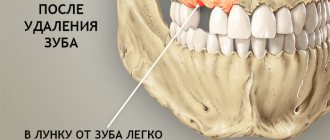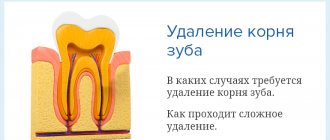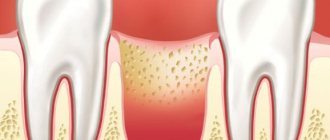- Main indications and contraindications
- Complex tooth extraction: features of the procedure
- Tools used
- Healing process after surgery
- Complex tooth extraction in Moscow: reviews of treatment at A-Medic
There are two main types of tooth extraction in dentistry - simple and complex.
The first is used when it is necessary to remove teeth with one root, and the second when the root has a complex structure and several branches. During complex surgical interventions, special instruments are used. Tooth extraction in Moscow is performed by the reliable dental clinic “A-Medic”. The company's employees have high professionalism and extensive experience, which allows surgical intervention with minimal risk of complications. The clinic is equipped with modernized equipment, thanks to which all stages of the procedure are controlled. The cost of a complex tooth extraction in the clinic is only 3,500 rubles.
Main indications and contraindications
Complex removal is required in a number of complex clinical cases when it is not possible to perform surgical intervention using standard techniques and instruments. Very often it is carried out in relation to the last painters (“eights”). As a rule, they do not have enough space, against which they begin to grow incorrectly (for example, erupt towards the cheek, injuring the mucous membrane), slowly erupt, accompanied by painful sensations. The last molars do not participate in the chewing process, so most often the dental surgeon decides to remove them in such situations.
Complex surgical procedures are resorted to in the presence of a chronic inflammatory process, against the background of which the bone tissue and the molar or premolar itself have fused. A complex operation cannot be avoided if the molar has several roots or its area is severely curved. Benign neoplasms (for example, granulomas or cysts) are often an indication for removal if the tooth is destroyed and there is no point in trying to restore it. Sometimes a complex extraction of a previously treated tooth is performed several times. This is due to the fact that it is not durable, its density is weakened, and it is capable of cracking.
As with any surgical intervention, there are a number of absolute and temporary contraindications to complex removal of molars or premolars. Among them:
- diseases of viral etiology;
- serious deviations from the cardiovascular system;
- pregnancy and lactation;
- blood diseases (anemia, poor clotting, leukemia);
- chronic pathologies during exacerbation;
- recent strokes and heart attacks;
- serious mental disorders (schizophrenia);
- long-term use of medications that affect blood clotting.
Elevator
When an impacted or unerupted tooth (most often wisdom teeth) needs to be removed, the dentist will use an elevator. The tool consists of a handle and a working part, which is used to extract the root. The elevator operates on the principle of a lever, that is, the doctor literally picks up the tooth from below and removes it from the bone tissue. Removing teeth using elevators is very traumatic, but in some situations you simply cannot do without them.
Elevator for tooth extraction
Complex tooth extraction: features of the procedure
Before performing a surgical intervention, the specialist prescribes the necessary diagnostic examination (instrumental and laboratory) to the patient. First, he is sent for an X-ray examination. Using this technique, it is possible to assess the general condition of the root system and clearly see the location of the tooth in the jaw. For a more detailed analysis, obtaining images of various dental structures layer by layer, computed tomography is prescribed. It makes it possible to detect in advance the factors complicating the surgical intervention, to establish the approximate time and complexity of the procedure.
Removal of a molar or premolar is always performed under the influence of an anesthetic. To avoid negative consequences, it is recommended to first visit an anesthesiologist to identify a possible allergic reaction to a particular substance. To determine contraindications (for example, exacerbation of a chronic disease), it is recommended to undergo laboratory diagnostics - a general blood test. In the absence of contraindications, they proceed to surgical intervention. The procedure and technique for implementing the removal technique are as follows:
- Conducting anesthesia. Depending on the age, neglect of the clinical case and the general physical condition of the patient, local or general anesthesia with a potent drug may be used.
- Incision of soft tissues and separation of gums.
- Sawing out a small area of bone tissue and the coronal part, sawing the septum (only if necessary).
- Gently rocking the tooth using special tools and removing it completely.
- Applying sutures to the gum area.
If the wisdom tooth is located next to the mandibular nerve, the procedure becomes a little more complicated. This is because its roots are able to surround the area of the nerve. In such a situation, the roots are divided and removed with extreme caution so as not to touch the nerve. To carry out high-quality surgical intervention, a qualified dental surgeon is required.
Tools used
If a simple elimination requires only two main tools - forceps and an elevator, then in the case of a complex elimination everything is a little different and much more auxiliary devices are required. The instruments are specially developed for dental surgery, which allows all manipulations to be performed without causing severe harm (the level of mechanical damage is minimized).
To extract a molar or premolar, forceps, a bur, an excavator or an elevator are used, and during surgery a scalpel, hammer, scissors, and chisel are used. Let's take a closer look at what the role is and in what situations each of the tools is used.
- forceps. They are used in situations where the coronal part has been preserved and the roots are located in such a way that they can be grasped with an instrument. The specialist sets the axis of the crown to align with the axis of the forceps. For each group of teeth, forceps of a certain shape are designed, having a working part - cheeks, handles, lock;
- elevator. It is used in relation to molars (particularly the eighth) and premolars in the upper jaw. If necessary, using this instrument, the dental surgeon loosens the tooth (or its remains) along with the root, after which it is dislocated with forceps and removed from the gums;
- excavator. According to the principle of operation, it is similar to an elevator; it is used for deep fractures of a molar or premolar. It has an angular working surface, making it easy to penetrate into the hole;
- bit. It is used to eliminate the outer wall of the alveolar process. It is often necessary in a situation where a tooth breaks off and it is not possible to get it out using an elevator or excavator;
- hammer. Its help is resorted to in cases where a tooth is removed using a chisel. The dentist places the instrument in the area between the root and the hole, and at this time his assistant, using a hammer, makes several blows to this area;
- scalpel. Often, complex removal requires making a small incision with minimal trauma. For this purpose, a scalpel is used;
- drill. A drill is usually used during separation, removal of multi-rooted teeth, or removal of bone tissue surrounding a molar or premolar. In such situations, the dental tissue is sawed and removed piece by piece. This is not a simple procedure; it requires sufficient qualifications of a specialist. It is more advisable to resort to it if the root canals have already been previously filled or when the last molar is growing incorrectly (in a horizontal position).
A-Medic dentistry practices complex tooth extraction in Moscow. Qualified specialists work here. For high-quality removal during surgical intervention, the above-described instruments are used. Additionally, the clinic provides all necessary manipulations and services: hemostatic sponge, anesthesia (conduction, infiltration, application), preparation, dressing (using Trichopolum or Alvogil), removal and application of sutures. To make an appointment, just call the numbers provided or fill out an application on the clinic’s official website, after which the administrator will contact you.
Piezo device
Along with a laser, a piezoelectric device is another modern device that makes the dental treatment process more comfortable and safe. The device generates ultrasonic waves that replace a traditional drill. It works almost silently; when removing teeth, it allows you to make incisions in the gums, the teeth themselves, and bone tissue. In this case, the cuts are made using ultrasonic vibrations, and the tip of the device does not come into contact with the surface being treated. Due to this, the tissues are practically not injured, the operation is carried out with high precision even in difficult-to-reach areas.
Piezo device
Healing process after surgery
After surgery, the recovery period begins. The duration of its continuation is individual, as a rule, 1-2 days. In particularly advanced clinical situations, negative symptoms may persist for about 5-7 days. After a few hours, the effect of the anesthetic wears off, causing the patient to experience severe discomfort. If the pain is pronounced and does not go away on its own, experts prescribe non-steroidal anti-inflammatory drugs and analgesics.
The day after the operation, redness and slight swelling may occur in the area affected by surgical instruments. It gradually goes away on its own when the blood supply to the area is normalized. Sometimes the patient needs to take antibacterial agents (as prescribed by the attending physician).
Immediately after tooth extraction, bleeding may occur. This is due to the fact that a small bloody clot appears in the formed hole. Most often, it can be stopped in the dental chair, but for some, the hemorrhage continues for another 1-2 days. Prolonged bleeding may be due to a number of factors, such as high blood pressure or a bleeding disorder.
To avoid the appearance of hemorrhagic syndrome, it is important to strictly follow all the instructions of the surgeon. People suffering from hypertension are advised to drink motherwort tincture before tooth extraction. With its help, the functioning of the nervous system is normalized and there will be no surges in blood pressure. To monitor the healing process after surgery, you need to see a dental surgeon on days 5-7. There is usually no need to remove sutures as they dissolve on their own. To avoid complications during the recovery period, the following measures are required:
- During the first days, it is recommended to brush your teeth with a soft brush and be especially careful so as not to touch the soft tissues. This will avoid bleeding;
- You should not eat food for the first 2-4 hours. Throughout the entire recovery period, only soft foods and drinks at room temperature are recommended. Chewing on the operated side is prohibited;
- do not rinse your mouth or take baths for the first 24 hours;
- do not undergo strenuous physical activity. Such actions cause an increase in blood pressure, which can lead to hemorrhage.
Complex tooth extraction in Moscow: reviews of treatment at A-Medic
Olga, 41 years old. Last month I had an operation to remove a tooth at A-Medic dentistry. I made an appointment with Ziyad Ganiev without any problems. He is a true professional in his field. The procedure was successful, the doctor gave recommendations, followed them completely, and there were no complications.
Pavel, 27 years old. For several years now I have been receiving treatment only at the A-Medic clinic. Recently my wisdom teeth started to erupt and hurt a lot. The doctor advised to remove it. Removal took place quickly and without any discomfort. I recommend A-Medic dentistry to everyone.
Natalya, 32 years old. "A-Medic" is my favorite dentistry. The atmosphere in the room is pleasant, the doctors are experienced, making an appointment is not difficult. The other day I needed to remove the eight. My friends told me that this would be a difficult and painful operation. I signed up for removal with the Blazhentseva Rada. The operation took place in just a few minutes, and the recovery period took only two days.
This is interesting: the tools that our ancestors used
It's surprising, but all modern hand tools for tooth extraction have been in use for several centuries. Of course, their ancestors looked very scary, and sometimes a simple operation led to very sad consequences, even death.
One of the first devices for removing teeth were pelicans, so named because of their external resemblance to the bird of the same name. They have been in use since the 14th century. The components of the device were a rotating claw and a base - the tooth was placed between them and twisted out of the hole.
Pelican
Another “torture instrument” of dentists was a special key. A claw was placed at the tip of the shaft, which allowed the tooth to be rotated around its axis. Fortunately, this method has not been used since the end of the 19th century.
Key
A rather unusual instrument is a goat's leg, with a double tip that resembles an animal's hoof. It was used to extract remains of tooth roots.
Goat leg
This is only a small part of the instruments previously used in dentistry. Most of them bear little resemblance to medical devices, causing associations with torture devices. No wonder people were afraid to go to the doctor! Perhaps it was then that a fear of dentists was formed, passed on to modern generations at the level of instinct. However, today there is simply no point in being afraid of dentists. Advanced instruments and devices, together with high-quality anesthesia, make the process of treatment and tooth extraction absolutely painless.
Notice
: Undefined variable: post_id in
/home/c/ch75405/public_html/wp-content/themes/UltraSmile/single-item.php
on line
45 Notice
: Undefined variable: full in
/home/c/ch75405/public_html/wp-content /themes/UltraSmile/single-item.php
on line
46
Rate this article:
( 1 ratings, average: 5.00 out of 5)
removal of a tooth









